Back to Dude Intelligence for Manufacturing Main Menu
The Operational Dashboard allows you to drill-down into your applications' data to give you a bigger picture into the work you are doing. This data updates every night and includes 3 full calendar years of data in addition to the current year through yesterday.
- Use the Dashboard drop down in the top right corner of the screen to change your Dashboard view.
- You can also filter the Dashboard using the drop down filters across the top. If you do filter using these drop downs, a green indicator will appear under that field to let you know you have made filter selections.
- To clear your filter selections, click the Clear All Filters button on the right side of the screen.

- Within each chart or section of the Dashboard, you can make selections to narrow down the data. Select the information in the graph you want to view and click the green checkmark. The rest of the dashboard will be filtered by these selections as well.

Cost by Purpose (Top 5)
Displays top 5 work order costs by Purpose Code.
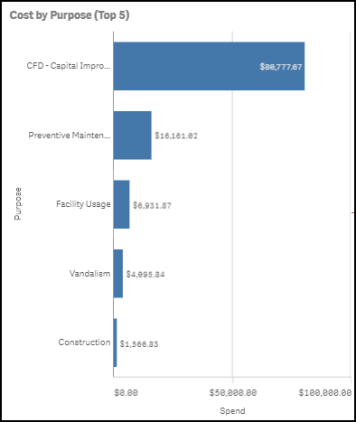
Employee Workload (Top 10)
Displays employee workloads by Purpose. *Note: The larger the box, the higher the workload for that Purpose Code.
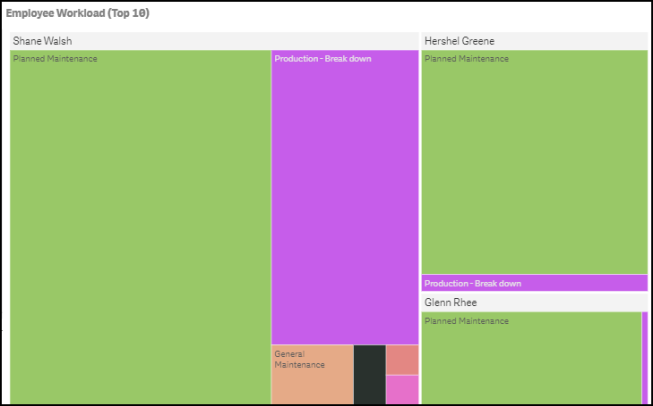
Cost by Craft (Top 5)
Displays work order costs by Craft.
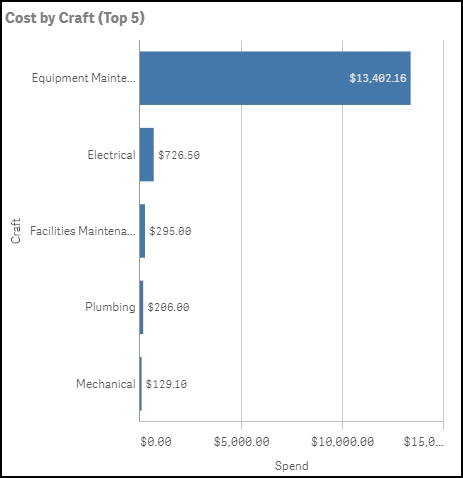
Employee Utilization (Top 5)
Displays how employees are utilizing their time by the number of jobs assigned and the hours worked.
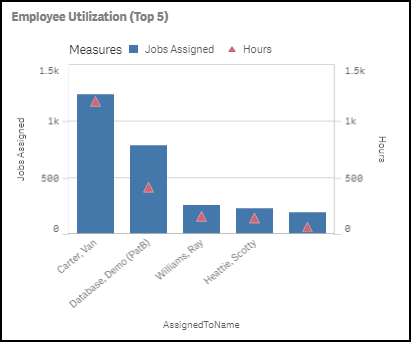
Work Orders by Status
Displays work order counts by status in a percentage. Hover over a section of the pie chart to see the actual work order count.
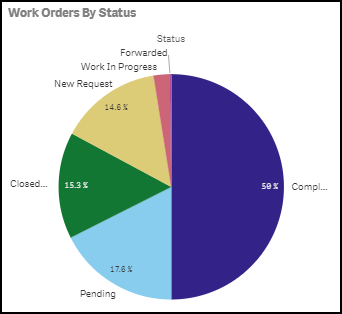
Cost by Purpose (Top 5)
Displays top 5 work order costs by Purpose Code.

Location Counts
Displays the work order count by Location. This graph is also colored coded by Craft. Hover over a color to see the work order count for that specific craft.

Cost by Location (Top 5)
Displays top 5 work order costs by Location
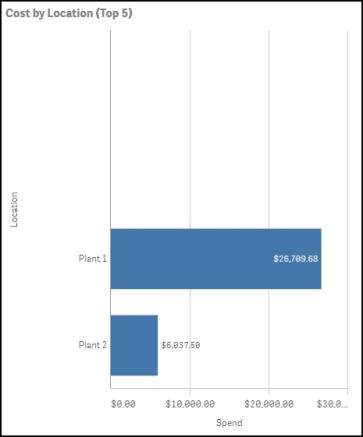
Location Completion Results
This section displays a mini Location report with work order completion details for different fiscal years.

A work order is considered on time if it has been completed by the Target Completion Date or the Requested Completion Date on the work order form. If the work order is completed after one of these dates, it is considered not completed on time. If there is not a Target Completion Date or a Requested Completion Date entered on the work order form, the system looks at the Priority to determine the length of time for completion:
- Low - user has 60 days to complete the work order from the request date to consider it on time.
- Medium - user has 30 days to complete the work order from the request date to consider it on time.
- High - user has 15 days to complete the work order from the request date to consider it on time.
- Emergency - user has 3 days to complete the work order from the request date to consider it on time.
On-Time Completion (OTC) By User
Displays the on-time completion percentage by user.
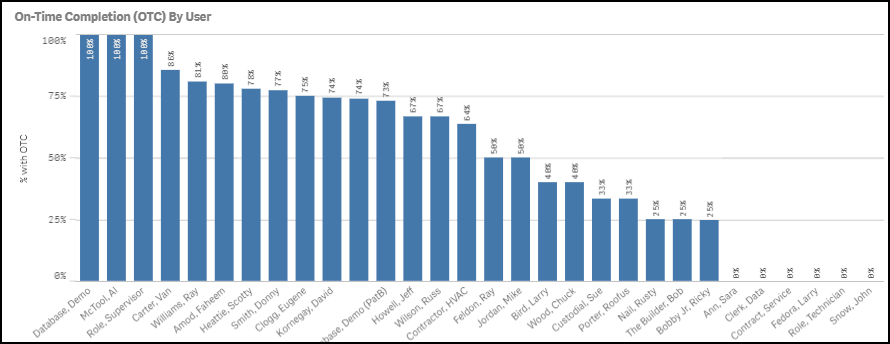
% of All WO's with OTC
Displays the on-time completion percentages for corrective maintenance, planned maintenance, and both combined. On the graphs, you will see a small indicator that represents where your organization is performing compared to peers in your industry. Your value will be displayed below the graph or in the middle of the circular graphs.
Green - The green section represents the top 20% of education clients.
Yellow - The yellow section represents average performance.
Red - The red section represents below average performance.
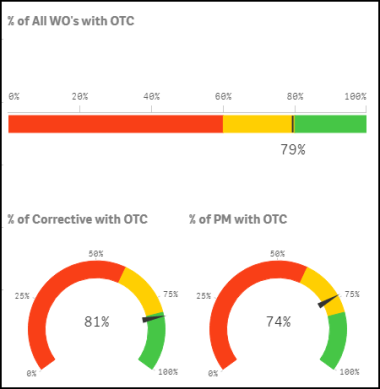
Assigned To Listing
This section displays a mini Assigned To report with work order on-time completion details.

Failure Reason Count Percentages (Top 5)
Displays equipment failure reasons in a percentage. Hover over a section of the pie chart to see the actual count of work orders with a specific equipment failure reason.

Failure Reason Costs (Top 5)
Displays the costs of each failure reason in a percentage. Hover over a section of the pie chart to see the actual cost of a specific failure reason. *Note: If the data contains zero values, it will not be displayed in the chart.

Equipment Failure Counts
Displays equipment failure counts by Purpose Code. On the y-axis, you will see the failure reasons. Hover over a bar on the graph to see the actual work order count.
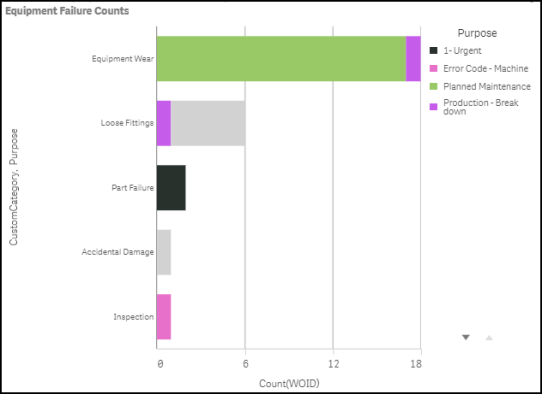
Work Order Listing
This section displays a mini report with work order details including equipment names.

Location Open Heat Map
Displays a count of work orders that have been open for a specific number of days (i.e. 0-30 days, 31-60 days, etc.). This data is broken down by Location. *Note: Cells that are highlighted have over 5 open requests. Open requests include work orders in the status of New Request, Work In Progress, and Pending. Each column is highlighted with a different color to indicate the increase in time. The Totals column is highlighted when there are over 20 requests.

Craft Open Heat Map
Displays a count of work orders that have been open for a specific number of days (i.e. 0-30 days, 31-60 days, etc.). This data is broken down by Craft. *Note: Cells that are highlighted have over 5 open requests. Open requests include work orders in the status of New Request, Work In Progress, and Pending. Each column is highlighted with a different color to indicate the increase in time. The Totals column is highlighted when there are over 20 requests.

Purpose Open Heat Map
Displays a count of work orders that have been open for a specific number of days (i.e. 0-30 days, 31-60 days, etc.). This data is broken down by Purpose. *Note: Cells that are highlighted have over 5 open requests. Open requests include work orders in the status of New Request, Work In Progress, and Pending. Each column is highlighted with a different color to indicate the increase in time. The Totals column is highlighted when there are over 20 requests.
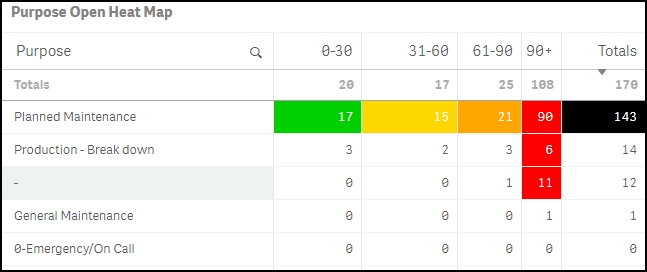
Assigned To Open Heat Map
Displays a count of work orders that have been open for a specific number of days (i.e. 0-30 days, 31-60 days, etc.). This data is broken down by Assigned To. *Note: Cells that are highlighted have over 5 open requests. Open requests include work orders in the status of New Request, Work In Progress, and Pending. Each column is highlighted with a different color to indicate the increase in time. The Totals column is highlighted when there are over 20 requests.
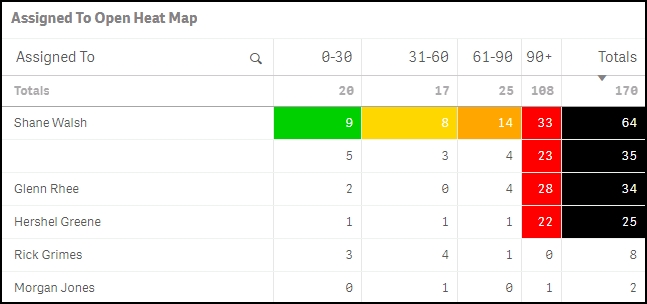
Total Downtime
Displays the sum of the downtime as indicated by the Downtime hr. and min. fields on the work order form.

Total Downtime Cost
Displays the sum of the downtime cost as indicated by the Cost field on the work order form.
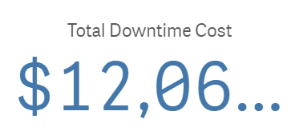
Downtime Hours By Equipment
Selecting Equipment from this list will filter the remaining sections of the dashboard to only reflect downtime values for the selected Equipment.

Downtime % by Type
Displays the percentage of total downtime hours and minutes for each Equipment Type.
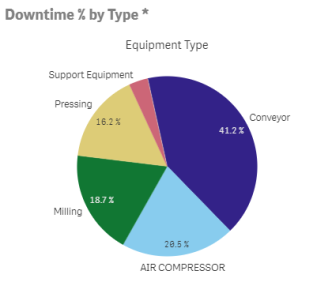
Downtime Hours by Type
Displays the sum of the downtime hours and minutes for each Equipment Type.

Work Order Listing
Displays a list of all work orders that include Downtime hours and minutes greater than 0.

Mean-Time-To-Repair
Displays the average repair time for equipment. On the x-axis you will see the data broken down by Classification. The system looks at the average time between reporting equipment failures (Date Reported) and the completion of the corrective action (Date Completed).
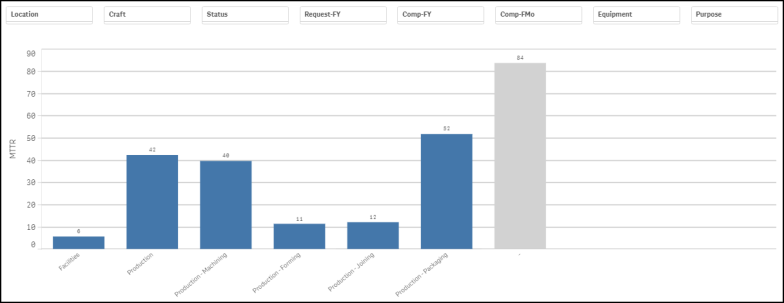
Work Order Listing
This section displays a mini report with work order details including equipment names.

